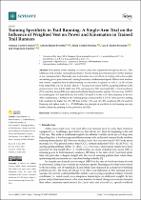Por favor, use este identificador para citar o enlazar este ítem:
https://repositorio.usj.es/handle/123456789/1003
Registro completo de metadatos
| Campo DC | Valor | Lengua/Idioma |
|---|---|---|
| dc.contributor.author | Carton-Llorente, Antonio | - |
| dc.contributor.author | Rubio-Peirotén, Alberto | - |
| dc.contributor.author | Cardiel-Sanchez, Silvia | - |
| dc.contributor.author | Roche-Seruendo, Luis Enrique | - |
| dc.contributor.author | Jaén-Carrillo, Diego | - |
| dc.date.accessioned | 2023-10-18T14:19:20Z | - |
| dc.date.available | 2023-10-18T14:19:20Z | - |
| dc.date.issued | 2023-07-14 | - |
| dc.identifier.citation | Cartón-Llorente, A.; Rubio-Peirotén, A.; Cardiel-Sánchez, S.; Roche-Seruendo, L.E.; Jaén-Carrillo, D. Training Specificity in Trail Running: A Single-Arm Trial on the Influence ofWeighted Vest on Power and Kinematics in Trained Trail Runners. Sensors 2023, 23, 6411. https://doi.org/10.3390/s23146411 | en_US |
| dc.identifier.issn | 1424-8220 | en_US |
| dc.identifier.uri | https://repositorio.usj.es/handle/123456789/1003 | - |
| dc.description.abstract | Participants in trail running races must carry their equipment throughout the race. This additional load modifies running biomechanics. Novel running powermeters allow further analyses of key running metrics. This study aims to determine the acute effects of running with extra weights on running power generation and running kinematics at submaximal speed. Fifteen male amateur trail runners completed three treadmill running sessions with a weighted vest of 0-, 5-, or 10% of their body mass (BM), at 8, 10, 12, and 14 km_h1. Mean power output (MPO), leg spring stiffness (LSS), ground contact time (GCT), flight time (FT), step frequency (SF), step length (SL), vertical oscillation (VO), and duty factor (DF) were estimated with the Stryd wearable system. The one-way ANOVA revealed higher GCT and MPO and lower DF, VO, and FT for the +10% BM compared to the two other conditions (p < 0.001) for the running speeds evaluated (ES: 0.2–7.0). After post-hoc testing, LSS resulted to be higher for +5% BM than for the +10% and +0% BM conditions (ES: 0.2 and 0.4). Running with lighter loads (i.e., +5% BM) takes the principle of specificity in trail running one step further, enhancing running power generation and LSS. | en_US |
| dc.format.extent | 10 p. | en_US |
| dc.format.mimetype | application/pdf | en_US |
| dc.language.iso | eng | en_US |
| dc.publisher | MDPI | en_US |
| dc.rights | Atribución 4.0 Internacional | * |
| dc.rights.uri | http://creativecommons.org/licenses/by/4.0/ | * |
| dc.subject | Endurance | en_US |
| dc.subject | Footpod | en_US |
| dc.subject | Running power | en_US |
| dc.subject | Wearable resistance | en_US |
| dc.title | Training Specificity in Trail Running: A Single-Arm Trial on the Influence of Weighted Vest on Power and Kinematics in Trained Trail Runners | en_US |
| dc.type | info:eu-repo/semantics/article | en_US |
| dc.identifier.doi | https://doi.org/10.3390/s23146411 | en_US |
| dc.rights.accessrights | info:eu-repo/semantics/openAccess | en_US |
| Aparece en las colecciones: | Artículos de revistas | |
Ficheros en este ítem:
| Fichero | Descripción | Tamaño | Formato | |
|---|---|---|---|---|
| Training Specificity in Trail Running.pdf | 570,09 kB | Adobe PDF |  Visualizar/Abrir |
Este ítem está sujeto a una licencia Creative Commons Licencia Creative Commons

